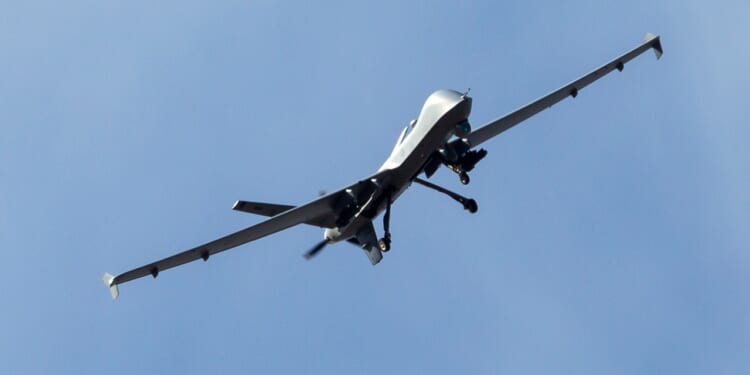The technological evolutions of the MQ-9 drone have ushered a new era of warfare in which killing a target is easier than ever before—with uneasy moral and legal implications.
The General Atomics MQ-9 Reaper, as an isolated system, is fairly unremarkable. With long wings and an efficient turboprop engine, the airframe was designed to loiter for hours, rather than impress with speed or maneuverability. Yet when considered as a system, the MQ-9 transcends its cumbersome airframe, becoming instead a game-changing strategic platform—one that has defined the nature of early 21st century warfare in certain respects, yet has raised numerous legal and ethical questions along the way.
The MQ-9 Reaper’s Specifications
- Year Introduced: 2007
- Number Built: 300+
- Length: 36 ft 1 in (11 m)
- Wingspan: 65 ft 7 in (20 m)
- Weight: 10,494 lb (4,760 lb)
- Engines: One Honeywell TPE331-10 turboprop engine
- Top Speed: ~300 mph (482 km/h); typical cruising speed 194 mph (313 km/h)
- Range: 1,200 mi (1,900 km); up to 27 hours’ endurance, depending on payload
- Service Ceiling: 50,000 ft (15,240 m)
- Loadout: 7 hardpoints; 3,800 lb (1,723 kg) payload capacity
- Aircrew: 0
The MQ-9 Reaper: A New Weapon for a New Kind of War
The MQ-9 has a modular belly full of sensors and weapons. Datalinks and satellite relays connect the fuselage to an operator located thousands of miles away, who uses the MQ-9’s suite of electro-optical.infrared equipment, synthetic aperture radar, and signal intelligence to observe battlefields on different continents. This is the true novelty of the MQ-9; it’s an airframe that can provide near-constant ISR capabilities and the airframe is remotely operated.
But the MQ-9 doesn’t just watch the battlefield; it can reach out and influence the field with lethal precision. Outfitted with the AGM-114 Hellfire missile, the MQ-9 provides commanders with a flexible and expedient strike option.
What’s so important about the MQ-9’s technical profile is that it changes the decision space. Persistent ISR lowers the cost of surveillance and raises confidence in identification. Datalinks shorten the time between observation and strike. And automated targeting aids reduce the number of manual steps in the kill chain. Those are engineering changes—but they have resulted in profound doctrinal and legal consequences.
When a sensor can follow a subject in perpetuity, and an operator, sitting stateside, can target that subject with a Hellfire missile, the outcome is an increased likelihood of killing a subject based on probabilities.
The Reaper Has Become Synonymous with Controversial Airstrikes
As the technological capabilities found in the MQ-9 evolved, they prompted parallel evolution in the way the US performs targeted killings. In the immediate aftermath of the 2001 AUMF, armed drones were used selectively, with higher use-thresholds, against identified al-Qaeda operatives in Afghanistan. The legal footing was relatively simple in those days, as strikes were being executed against declared adversaries in a declared theater.
But as MQ-9 technology improved, more options presented themselves, complicating the legal framework. As sensor fidelity and airframe endurance improved, the drone’s capabilities expanded—and doctrine and practice shifted accordingly. Two modes of strike emerged: “Personality” strikes, against linguistically or biographically identified individuals, and “signature” strikes, which were based merely on behavioral patterns that were interpreted as hostile. The latter, of course, depends on probabilistic inference drawn from persistent sensing, rather than any form of positive, real-time identification.
The successive US administrations with access to the novel MQ-9 tech have placed different emphases on constraints, transparency, and delegation. But the trend line is clear. The Obama years were especially formative, with internal standards becoming formalized; the Obama administration, even as public statements emphasized restraint, expanded the geographical reach of legal authority, with the program’s reliance on covert authorities in some theaters blurring the lines between wartime operations and counterterrorism operations.
The technological evolutions found in the MQ-9 have ushered a new era of warfare, in which commanders have the capacity to execute targets, near-instantly, from remote locations. The moral and legal implications of such remarkable capabilities have not been resolved, even as the technology has become entrenched in US doctrine.
About the Author: Harrison Kass
Harrison Kass is a senior defense and national security writer at The National Interest. Kass is an attorney and former political candidate who joined the US Air Force as a pilot trainee before being medically discharged. He focuses on military strategy, aerospace, and global security affairs. He holds a JD from the University of Oregon and a master’s in Global Journalism and International Relations from NYU.
Image: Shutterstock / BlueBarronPhoto.

















